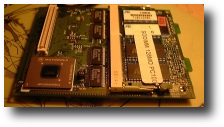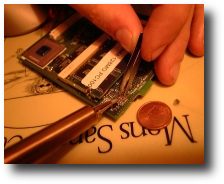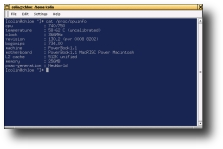[
back] (
franšais)
The whole howto has already been written
here, so I don't have to
copy-paste it, just visit the page to get an idea of what you want to do to your processor card.
This is just a success report with some photos of the surgery.
So, here you go. I don't take any responsability if you miss it, but that's unlikely to
happen as I'm sure you'll be over-concentrated ;-)
- Rip your powerbook apart to extract the processor board. This is well explained on the upper
cited page.
- Play fair, unplug the AC adaptor, remove the battery, touch a grounded surface, and so on.
- Open the keyboard, remove the heat dissipator, unplug the processor card.
|

|
- I advise you remove the so-dimm Ram, too.
- So, up to the soldering!
I decided to overclock from 333MHz to 366, by changing the clock multiplier
from 5x to 5.5x, for a few reasons:
- I didn't want to overclock the bus, as I don't know how would the devices
(PCI bus, video card, IDE bus) support it ;
- I didn't want to go too far at once - try 366, try it for a few weeks,
if it's stable I'll perhaps go to 400.
- Changing the clock multiplier from 5 to 5.5x required resoldering a single
resistor - the less I modify, the less I could break.
- On the image to the right, you can see a friend of mine, Yann, resoldering a
one-millimeter-long resistor. Yes, I really trust him ;-) He's for sure better
than me at such things...
|

|
- Well, the resistor was quite easy to remove, harder to put back in its new
place doing a clean job. Finally we got it well put... Time to put back the card
back in the laptop and reboot (don't forget the heat plate) !
- Crossing folders we rebooted the computer, and, ouf, we didn't fuck it up :)
Everything runs ok.
- Some facts...
- dnetc crunches rc5 keys (yes, I know it's over, that was just as a benchmark) at
about 1.2 Mkeys/sec instead of 1.0 MKeys/s before;
- glxgears, the opengl demo, went from 120 fps to 147;
- Chromium-BSU needs more enemies on the screen to slow down, and its average framerate
went from 25 to 33.
- Divx movies up to 640x480 are now viewable (with a little framedrop, but that goes
unnoticed unless you know it), was 512x384 before.
- According to MRTG graphs, the average temperature is about the same as before.
|

|
Well, all in all, that seems to be a successful overclock, and as it doesn't heat up more than
before, I'll probably try 400MHz in a few weeks. Going from 366 to 400 has the advantage of
requiring resoldering a single resistor, once again - not too much hassle at once ;-)
Update: I overclocked the Lombard to 400MHz today (2002/10/26). Still runs fine (2003/07/15).

